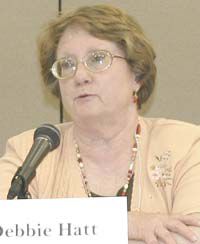A guide to small business finance
| Debbie Hatt on the Got Money panel. |
A person may have the perfect business plan or the greatest inventions, but what about the money to finance the venture? One of the many breakout sessions at the Rural Business Conference was concerned with financing small business and how to apply for the monies available.
Stan Nakano, the district director for the U.S. Small Business Administration said only New York, Chicago, Los Angeles and Miami do more loans than are done in Utah. “Last year we did a record number of loans to women and minorities. In Emery and Carbon counties, we did 17 loans which amounted to $2.1 million,” said Nakano.
Nakano introduced the panelists who represent public and private lending institutions in Utah. Steve Price is the assistant director for economic development in the U.S. Small Business Administration. Roger Koon is the business and cooperative program specialist for the U.S. Department of Agriculture. Robert Edminster is the vice president of Mountain West Small Business Finance. Debbie Hatt is from the department of economic, community and housing development, for the Southeastern Utah Association of Government.
Price said, “Small business generates most of the jobs in rural Utah and is the backbone of the U.S. economy. But, after five years only a small percentage of those small businesses survive.”
The Small Business Administration was formed to help small business get the money they need. Their job is to facilitate the relationship between small business and the banks and lending institutions. The SBA offers a government guarantee to lending institutions encouraging them to lend to small business owners.
Banks want short term loans and the SBA allows for longer loan maturity loans. This program doesn’t cost the taxpayer money and the approval process is quite similar to that of a lending institution. The SBA offers procurement programs, international trade programs, along with numerous others to help the small business owner.
Koon explained the programs the USDA has to offer. “We have many different programs to help the three main sectors, housing, community, and business and cooperative. We have several avenues for financing,” said Koon.
USDA has programs to help small business in varying amounts and with varying rates of interest. They have money for renewable energy programs and a rural economic development loan program. Many projects in this area have been financed by USDA, such as energy saving projects for small businesses.
Koon said the USDA can help with feasibility studies and business plans also. He noted several projects he has been involved in where water treatment plants or fire stations have been refurbished and communities have been built or rebuilt.
Edminster said in his capacity with Zions Bank, he is not a government employee, but his job is to work with government agencies to help customers with small businesses. His is a partnership with the agencies, and he oversees the 504 program for Zions. “We administer the long term loans. We partner with banks and credit unions to help those in small businesses,” said Edminster.
In addition, Edminster said there are two things small businesses must have. The first is cash and the second is a building. The small business owner must have at least 10 percent cash up front to qualify for financial help with this program. They must also have been in business for not less than two years. “We try to make the deals we make attractive to lending institutions. The SBA and government in general wants to foster economic development,” stated Edminster.
Hatt stated the SEUALG has loan programs to the small business owners in the four county area. They handle the gap financing. That is those areas of small business needs that are not covered by other loan programs and lending institutions. “We are targeting micro-business with loans up to $20,000, hoping to encourage their growth. A business can use this funding for most parts of expanding their business,” said Hatt.
Some things the SEUALG cannot finance are existing debt, silent partnerships, stock purchases, or hobby businesses. They require collateral and are much more interested in the business plan and cash flow. Their flexible loan terms run for up to seven years. If there is a need, the SEUALG board can work on more flexible loan terms and payment deferrals.
One thing all of the advisors agreed on was the completion of a business plan by the potential small business owners. He must do his homework before approaching a lending institution. A thorough financial statement must accompany the business plan. For help with a business plan, the panel suggested visiting with a counselor. To get free counseling, go to www.score.org.

